文章信息
- 李言阔, 钱法文, 单继红, 李佳, 袁芳凯, 缪泸君, 谢光勇
- LI Yankuo, QIAN Fawen, SHAN Jihong, LI Jia, YUAN Fangkai, MIAO Lujun, XIE Guangyong
- 气候变化对鄱阳湖白鹤越冬种群数量变化的影响
- The effect of climate change on the population fluctuation of the Siberian crane in Poyang Lake
- 生态学报, 2014, 34(10): 2645-2653
- Acta Ecologica Sinica, 2014, 34(10): 2645-2653
- http://dx.doi.org/10.5846/stxb201304150715
-
文章历史
- 收稿日期:2013-4-15
- 网络出版日期:2014-2-20
2. 中国林业科学研究院森林生态环境与保护研究所, 国家林业局森林保护学重点实验室, 北京 100091;
3. 东北林业大学野生动物资源学院, 哈尔滨 150040;
4. 江西省野生动植物保护管理局, 南昌 330038
2. Key Laboratory of Forestry Protection of State Forestry Administration, Research Institute of Forest Ecology, Environment and Protection, Chinese Academy of Forestry Sciences, Beijing 100091, China;
3. College of Wildlife Resources, Northeast Forestry University, Harbin 150040, China;
4. Wildlife Service of Jiangxi Province, Nanchang 330038, China
在过去半个世纪里,气候及其变化对鸟类的影响一直是鸟类学家关注的焦点之一[ 1,2 ],这些研究涉及气候变化对物种分布、物候、繁殖行为、种群数量以及群落组成与结构的影响[ 3,4 ]。面对气温的升高,很多物种的分布区北移或向更高海拔地区转移[ 4,5 ]。有些鸟类物种将它们的繁殖时间和迁徙日期等季节性节律提前,通过改变物候时间来适应气候变化[ 4,5 ]。一些食物链高层的物种由于无法及时地适应气候的变化,导致繁殖时间与食物丰裕期不重叠,使其种群受到明显的不利影响[ 6 ]。
由于自然种群在经历一个数量波动后通常会进行种群数量的调节,因此气候变化对种群数量的影响很容易被种群数量的密度制约性调节所掩蔽[ 3 ]。但是近年来的研究表明,气候会对动物的种群动态有较强的影响[ 7,8 ],例如极端气候事件可能会直接导致死亡率的迅速提高,甚至导致局部种群的灭绝[ 9,10 ],也可能通过影响食物资源的数量和质量而施加间接的影响[ 11 ]。天气的常规变化对动物种群的影响则没有极端天气的影响迅速和明显[ 12 ],甚至存在时滞效应,即在动物生活史某一阶段的气候条件对动物种群的影响要经过一定的时间后才显现出来[ 10 ]。在全球变化的背景下,理解一个迁徙物种某一生活史阶段的气候条件如何对其后来的存活施加影响,成为一个重要的研究议题[ 14 ].
白鹤(Grus leucogeranus)又名西伯利亚鹤,其全球种群现存仅约3 500—4 000只个体,被IUCN红皮书列为极度濒危物种[ 15 ],也被我国列为国家I级重点保护物种[ 16 ],在我国长江中下游越冬,在西伯利亚繁殖。近年来,鄱阳湖越冬白鹤种群数量表现出较大的波动[ 17 ]。本研究分析了鄱阳湖国家级自然保护区1983年到2011年共29a间保护区内越冬白鹤最大数量的年际变化,探讨了白鹤数量变化与其越冬地和繁殖地气候变化的关系,主要检验了:(1)白鹤种群数量变化与其越冬地当年的气候变量是否存在显著的相关性;(2)白鹤种群数量变化是否与白鹤繁殖地当年的气候变量存在显著相关性;(3)白鹤越冬地气候条件对白鹤种群数量波动的影响是否存在时滞效应。
1 研究地区概况鄱阳湖湿地是我国最大的淡水湖泊湿地,也是迁徙水鸟的重要越冬栖息地,位于长江南岸,江西北部,地理坐标为115°49′—116°46′E,28°11′—29°51′N,属亚热带湿润季风型气候,热量丰富,雨量充沛,无霜期长,四季分明。年平均气温17—17.8 ℃,年际变化不大。南北相差1 ℃左右。高值区在南部,低值区在北部。气温季节性变化明显,无霜期平均为246—284 d,年平均降水量1 636.4 mm,年平均日照1 702 h,高于10℃积温平均为5 244—5 666 ℃,年辐射总量为460—477 kJ/cm2[ 18 ]。
鄱阳湖是季节性过水湖泊、连河湖,承接赣江、抚河、信江、饶河、修水五大河的来水,经调蓄后经湖口进入长江,流域面积16.2×104 km2,是一个完整的水系。同时,鄱阳湖水位也受到长江来水的影响,长江水时有倒灌入湖现象。洪水季节,鄱阳湖水位高涨、湖面宽阔、一望无际。枯水季节,鄱阳湖水位下降,洲滩出露,湖水归槽,蜿蜒一线。洪、枯水期的水域面积、水容积相差极大。“高水是湖,低水似河,洪水一片,枯水一线”是鄱阳湖区的自然地理特征。
2 研究方法鄱阳湖国家级自然保护区1983—1998年白鹤最大种群数量采用该保护区1983年到1998年越冬白鹤数量的最大监测值[ 19 ],1998年以后鄱阳湖国家级自然保护区内的最大白鹤种群数量参考了该保护区2000—2008年的监测值[ 20 ]、本研究于1998—2011年开展的环鄱阳湖水鸟调查在该保护区内记录的白鹤数量[ 17 ],以及其他相关报道中的白鹤种群数量值[ 21,22,23 ],以其中的最大数量作为鄱阳湖国家级自然保护区每年白鹤最大种群数量。鄱阳湖区白鹤越冬期(10、11、12月、翌年1月到3月)的气象数据引用《中国地面气候资料月值数据集》南昌监测站1980—2011年的月平均气温、月平均最低气温、月平均最高气温、月降水量数据;白鹤繁殖地繁殖期的气象数据来自俄罗斯雅库特Bukhta Tiksi气象监测站(128°54′36″E,71°34′48″)的月值气象数据,包括6、7月和8月的月平均气温、月平均最低气温、月平均最高气温、月降水量数据。
本研究使用Pearson相关分析检验了白鹤种群29年间的数量变化与白鹤越冬地和繁殖地各月的平均气温、平均最低气温、平均最高气温和降水量的相关性,并检验了越冬地气候变量与其后10a内白鹤种群数量变化的相关性。考虑到极端值对相关分析会产生较大的影响,对相关性分析结果进行检验以消除极端值的影响。进而,本研究以白鹤种群数量作为因变量,将与其存在显著相关性的气候变量作为自变量,进行多元线性回归分析,建立基于越冬地和繁殖地气候变化的白鹤种群数量动态预测模型。数据分析在Spss13.0中完成。
3 研究结果 3.1 白鹤越冬地与繁殖地的气候波动1980—2011年白鹤越冬地越冬期平均气温为(11.0±0.1)℃,表现出明显的年际波动(图1),尤其是在1997年以后,平均气温升高,且年际波动幅度增加。1997—2011年白鹤越冬期平均气温为(11.5±0.2)℃,较1980年到1996年的白鹤越冬期平均气温(10.6±0.1)℃升高了0.9 ℃,导致30年来白鹤越冬期的平均气温略呈线性增长趋势(R2=0.375,F=17.988,df=31,P=0.000),增长斜率为0.050 ℃。相同的变化趋势也见于平均最高气温和平均最低气温。越冬期平均降水量为(529.0±27.2) mm,年际变化比较大(图1),虽然总体并无明显的线性增减趋势(R2=0.001,F=0.036,df=31,P=0.851),但是1996年后年际波动幅度增大。

|
| 图 1 1980—2011年鄱阳湖白鹤越冬期平均气温与降水量变化趋势 Fig. 1 the change trends of the average air temperature and precipitation in the Poyang lakes during the wintering period of Siberian crane during 1980 to 2011 |
白鹤繁殖地繁殖期的平均气温为(6.3±0.3)℃,年际波动较大(图2),最大值为2010年的9.0 ℃,最低值为1984年的3.4 ℃;平均最低气温和平均最高气温与平均气温表现出相同的波动趋势,虽然没有明显的线性增减趋势,但是年际波动幅度增大。繁殖地繁殖期的降水量平均为(141.5±12.1) mm,表现出剧烈的年际波动,最低值为2010年的63.5 mm,最大值为1996年的289.1 mm,呈现出“高峰-低谷-高峰”的波动趋势(图2)。
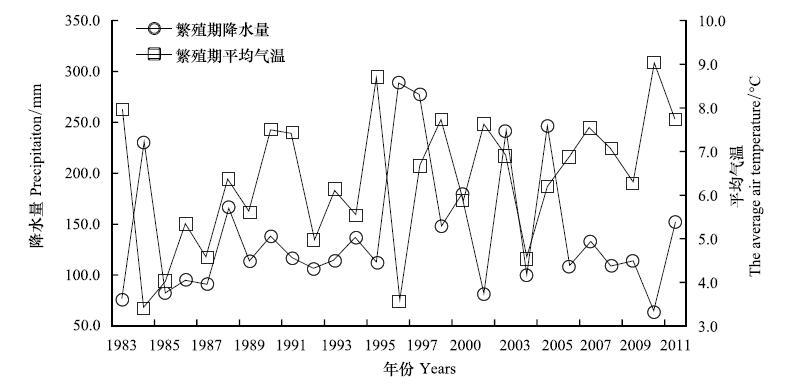
|
| 图 2 白鹤西伯利亚繁殖地繁殖期降水量与平均气温年际变化趋势 Fig. 2 the trends of precipitation and average air temperature in the breeding period of Siberian cranes in the Siberia |
鄱阳湖国家级自然保护区1983—2011年冬季白鹤年最大数量的平均值为(2 130±153)只,最小数量出现在1992年,为725只,最大数量出现在2011年,为3358只;种群数量整体呈显著地线性增长趋势(R2=0.454,F=22.441,df=28,P=0.000),但年际波动较大(图3)。
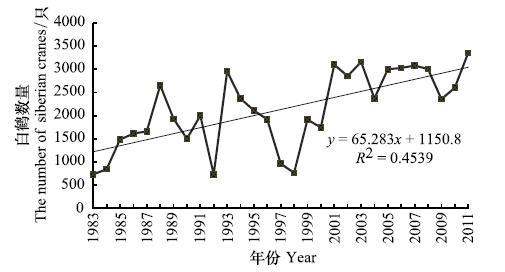
|
| 图 3 鄱阳湖国家级自然保护区1983—2011年最大白鹤数量年度变化趋势 Fig. 3 the change trends of the maximum number of Siberian crane wintering inside the Poyang Lake National Nature Reserve during 1983—2011 |
不考虑气候影响的时滞,1983年冬季到2011年冬季鄱阳湖国家级自然保护区内越冬白鹤的最大数量与白鹤越冬期当年各月的气温和降水量相关系数较小,均没有显著的相关性:10月平均最低气温(r=0.276,P=0.147,n=29)、10月平均最高气温(r=0.255,P=0.181,n=29)、10月平均气温(r=0.294,P=0.121,n=29)、10月降水量(r=-0.142,P=0.462,n=29);11月平均最低气温(r=0.266,P=0.163,n=29)、11月平均最高气温(r=0.126,P=0.515,n=29)、11月平均气温(r=0.221,P=0.249,n=29)、11月降水量(r=0.093,P=0.632,n=29);12月平均最低气温(r=0.081,P=0.674,n=29)、12月平均最高气温(r=-0.001,P=0.994,n=29)、12月平均气温(r=0.055,P=0.778,n=29)、12月降水量(r=0.036,P=0.853,n=29)。
考虑气候变化影响的时滞,10月份平均最高气温与2a后白鹤数量存在显著正相关(r=0.441,P=0.017,n=29),去除极端值,两者的相关性并不显著(r=0.329,P=0.087,n=28);10月份平均最高气温与3a后的白鹤数量存在显著正相关(r=0.413,P=0.026,n=29),去除极端值,两者之间的相关性不显著(r=0.303,P =0.116,n=28),10月平均最低气温与4a后,即第5年保护区白鹤最大数量存在显著的正相关(r=0.387,P=0.038,n=29),与保护区5a后白鹤最大数量存在正相关(r=0.500,P=0.006,n=29),与6a后,即第7年的保护区白鹤最大数量存在显著的正相关(r=0.595,P=0.001,n=29,图4);10月份平均气温与保护区5a后白鹤最大数量存在正相关(r=0.394,P =0.034,n=29),与6a后白鹤数量存在显著正相关(r=0.389,P =0.037,n=29)。
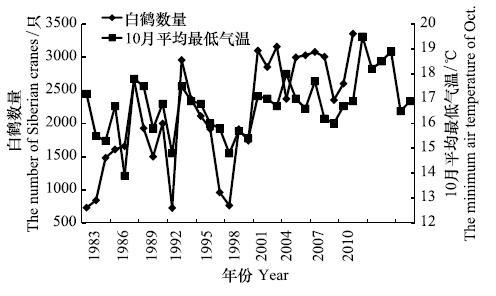
|
| 图 4 鄱阳湖国家级自然保护区1983—2011年白鹤最大数量与越冬地6年前10月平均最低气温的相关性 Fig. 4 the correlation of the maximum number of Siberian cranes in the Poyang Lake National Nature Reserve and the average minimum air temperature of Oct. before 6 years |
白鹤越冬期11月份降水量与6a后保护区内白鹤最大数量存在显著正相关(r=0.473,P=0.010,n=29),但是极端值的影响较大,去除极端值,两者之间的相关性并不显著(r=0.305,P=0.122,n=27)。12月份降水量、平均气温、平均最高气温、平均最低气温与10a内白鹤种群数量均无显著的相关性。白鹤越冬期翌年1月份降水量与5a后鄱阳湖国家级自然保护区白鹤最大数量存在显著正相关(r=0.401,P=0.031,n=29),去除极端值,两者的相关性并不显著(r=0.346,P=0.072,n=28)。1月平均最低气温与6a后白鹤数量存在显著正相关(r=0.417,P=0.024,n=29),同样受极端值影响较大,去除极端值,两者的相关性不显著(r=0.302,P=0.120,n=28)。
白鹤越冬期2月平均最低气温与1a后的鄱阳湖国家级自然保护区白鹤最大数量均存在显著正相关(r=0.367,P=0.050,n=29),但受极端值影响较大,去除极端值,两者之间不存在显著的相关性(r=0.316,P=0.101,n=28)。越冬末期3月平均气温与5a后白鹤数量存在显著正相关(r=0.569,P=0.001,n=29,图5),3月平均最低气温与5a后白鹤数量存在显著正相关(r=0.526,P=0.003,n=29,图6),3月平均最高温度与5a后白鹤数量存在显著正相关(r=0.570,P=0.001,n=29,图7),3月平均最高气温与6a后白鹤数量存在显著正相关(r=0.374,P=0.045,n=29)。
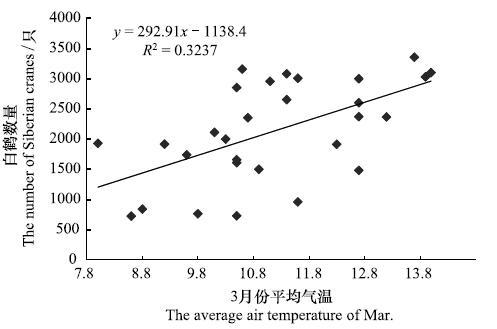
|
| 图 5 鄱阳湖国家级自然保护区1983—2011年白鹤最大数量与其5a前越冬地3月平均气温的相关性 Fig. 5 The correlation between the maximum number of Siberian cranes in the Poyang Lake National Nature Reserve and the average air temperature of March in wintering area before 5 years |
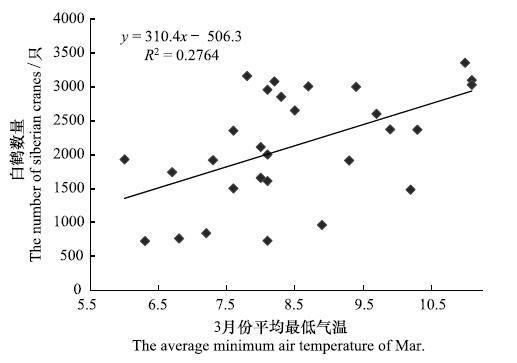
|
| 图 6 鄱阳湖国家级自然保护区1983—2011年白鹤最大数量与越冬地5a前3月平均最低气温的相关性 Fig. 6 The correlation between the maximum number of Siberian cranes in the Poyang Lake National Nature Reserve and the average minimum air temperature of March in winteirng area before 5 years |
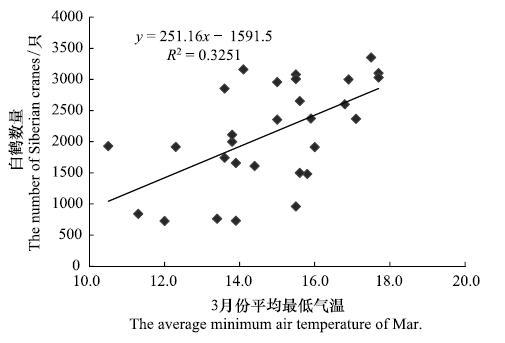
|
| 图 7 鄱阳湖国家级自然保护区1983—2011年白鹤最大数量与越冬地5a前3月平均最高气温的相关性 Fig. 7 The correlation between the maximum number of Siberian cranes in the Poyang Lake National Nature Reserve and the average maximum air temperature of March in winteirng area before 5 years |
鄱阳湖国家级自然保护区1983—2011年冬季白鹤最大数量与繁殖期的总降水量没有显著的相关性(r=0.031,P=0.885,n=25),同样与繁殖期各月的降水量也不存在显著的相关性(6月:r=-0.064,P=0757,n=26;7月:r=0.307,P=0.128,n=28;8月:r=-0.155,P=0.439,n=27)。鄱阳湖国家级自然保护区白鹤最大数量与繁殖地6月和8月的平均气温、平均最低气温以及平均最高气温均没有显著的相关性,与7月份的平均气温、平均最高气温、平均最低气温存在显著的正相关(表2)。
|
Pearson相关分析 Pearson correlations |
|
|
|
| 相关系数Correlation coefficient | 0.116 | 0.096 | 0.140 | 0.483 | 0.471 | 0.426 | 0.247 | 0.228 | 0.204 |
| P | 0.556 | 0.627 | 0.479 | 0.009 | 0.011 | 0.024 | 0.205 | 0.244 | 0.298 |
| n | 28 | 28 | 28 | 28 | 28 | 28 | 28 | 28 | 28 |
将鄱阳湖国家级自然保护区白鹤越冬种群数量的最大值作为因变量,与其存在显著相关性的气候变量作为自变量,进行Stepwise线性回归分析,结果表明,6a前的10月平均最低温度、2a前10月最高温度及5a前的10月平均气温是显著的预测变量,共同解释了鄱阳湖国家级自然保护区白鹤种群数量变化的74.8%(R2=0.748,F=23.807,df=27,P=0.000)。回归模型为Y=-18 101+53.150X1+29.610X2+22.363X3,式中Y为鄱阳湖国家级自然保护区每年越冬白鹤种群的最大数量,X1为6a前10月平均最低气温,X2为2a前的10月平均最高气温,X3为5a前的10月平均气温。该模型较好地拟合了鄱阳湖国家级自然保护区白鹤种群数量变化趋势(图8)。

|
| 图 8 鄱阳湖国家级自然保护区白鹤种群数量变化趋势与基于越冬地气候的白鹤种群增长模型对白鹤种群数量变化趋势的预测 Fig. 8 the trends of observed Siberian crane maximum number in the PLNNR and the predicted fluctuation of Siberian crane by the climate-based model |
全球白鹤可以分为3个种群:东部种群,数量最大的种群,主要在西伯利亚东北部繁殖,在中国长江中游流域越冬;中部种群,主要在西伯利亚库诺瓦特(Kunovat)河谷繁殖,在印度拉基斯坦邦(Rajasthan)的克拉迪奥国家公园(Keoladeo National Park)越冬,该种群可能已经消失,自2001/2002年冬季一直没有再发现;西部种群,主要在西西伯利亚(west Siberia)中部繁殖,在伊朗里海(Caspian sea)南岸越冬,从2006/2007年冬季之间仅记录到1只个体[ 15 ]。这意味着,近年来鄱阳湖区成为白鹤主要的越冬地,几乎整个白鹤全球种群均在该区越冬[ 15 ]。因此,该区白鹤种群数量的变化可以很好地反映全球白鹤种群的数量动态。又由于该种群的繁殖地主要集中在雅库特(Yakutia)和西西伯利亚,这意味着白鹤东部种群的繁殖地和越冬地比较固定,分析气候变化对该种群的影响可以消除广泛分布区的影响,有利于揭示气候变化与种群波动的相关性。
本研究发现,不考虑气候影响的时滞效应时,越冬期当年各月的气候条件与种群数量不存在显著的相关性。白鹤通常在当年10月份到达鄱阳湖,10月份到12月份除非出现极端不利的气候事件,否则这个时间段的气候对白鹤通常不会产生很大的影响。本研究也首次发现白鹤越冬地的气候条件对白鹤种群数量的影响存在时滞效应,这种影响通常在3a后开始变得明显,尤其是其越冬地10月份的气温变量与4a后的白鹤种群数量开始出现显著的相关性,其中与6a后白鹤的种群数量的相关性最强。这意味着白鹤越冬地10月份的气温对白鹤种群数量的影响要在4a后开始明显,这种时滞效应可能与气温对幼鹤的影响以及白鹤的性成熟年龄是相关的。一方面,10月份是白鹤食物苦草繁殖生长旺期,一般说来,较高的水温下,植物生长旺盛,吸收的营养增多,同时生产量也增加,可以给越冬白鹤提供丰富的食物,同时越冬期温暖的气候也有利于白鹤在越冬地的存活,共同改善了白鹤在越冬地的存活状态。另一方面,通常白鹤的性成熟年龄为3—5龄,适宜的冬季可能有利于更多的幼鹤存活到繁殖年龄,使3a后到5a后这些个体能够成功繁殖,带来白鹤种群数量的增加。
相反的情况是,越冬地恶劣的气候会导致几年后白鹤种群数量的减少。虽然鄱阳湖区恶劣天气造成的幼鹤死亡率尚缺少研究数据,但是从恶劣天气对其他大型涉禽如东方白鹳的影响来看,鄱阳湖的水面结冰有时会造成栖息于其中的涉禽被冰冻住双腿而受伤[ 24 ],与之体型相近的白鹤可能也面临同样的问题。同时,冬季寒冷的天气会增加动物体温调节所需的能量[ 25 ],而恶劣的冬季可能伴随着食物可获得性的下降,譬如寒冷的冬季雨后或雪后的结冰不利于草食类动物觅食,使动物在恶劣环境下增加的能量需求无法从食物中得到补充[ 26 ],能量供应和能量需求之间的不平衡会导致动物冬季死亡率的增加[ 25 ],即使没有直接导致个体的死亡,也可能影响白鹤的能量积累,使其体况下降,影响其在迁徙过程中的存活率。
能量是影响迁徙鸟类种群动态的一个重要因子,一些不能储存足够能量的鸟类甚至无法及时迁徙,从而会留在越冬地[ 27 ]。在候鸟停歇地的研究表明,饥饿会导致个体,尤其是幼体在停歇地无法成功地躲避捕食者[ 28 ]。研究发现,除了白鹤越冬初期10月份的气候条件与若干年后白鹤种群数量存在显著的相关性以外,白鹤越冬末期3月份的气候变量也与若干年后的白鹤种群数量存在显著的相关性,而越冬中期的气候条件与白鹤的种群数量则没有显著的相关性。白鹤通常在3月中下旬开始迁徙[ 19 ],3月份可能是白鹤迁徙之前补充能量的关键时期,如果这一时期白鹤经历了恶劣的天气而无法获得充足的能量,可能会影响白鹤尤其是白鹤幼体在迁徙过程中的存活率。
多元线性回归分析表明越冬地6年前的10月平均最低温度、2a前10月最高温度及5a前的10月平均气温是鄱阳湖国家级自然保护区白鹤最大种群数量变化的显著预测因子,这3个变量可以共同解释鄱阳湖区白鹤数量变化的74.8%,前两个变量可以共同解释白鹤数量变化的71.4%。按照模型预测,2012年和2013年白鹤种群数量与2011年冬季相比,种群数量变化较小,预测值分别为3644只和3382只,2014与2011年接近,其后白鹤数量下降,在2016年出现1次低谷,数量降至2200余只。
白鹤在雅库特的繁殖地属于低地苔原带景观,气温表现出剧烈的季节性变化和年际变化[ 29 ]。白鹤的繁殖成功率在很大程度上受到繁殖地5月下旬到6月上旬气候的影响,繁殖成功的雌雄对占总雌雄对的比例年际变化幅度达4.3%—83.3%[ 29 ]。本研究发现白鹤繁殖地7月份的气温变量与白鹤种群数量存在显著的相关性,这一相关性可能源于7月份较高的温度有利于白鹤食物资源的生长,能够给育雏期的白鹤提供更丰富的食物资源,从而导致更多的个体能够存活下来。关于白鹤繁殖地气候对白鹤育雏行为的影响的研究尚未见报道,这一领域的研究有待开展。
| [1] | Lack D. The Natural Regulation of Animal Numbers. Oxford: Oxford University Press, 1954. |
| [2] | Both C, Bouwhuis S, Lessells C M, Visser M E. Climate change and population declines in a long-distance migratory bird. Nature, 2006, 441(7089): 81-83. |
| [3] | Crick H Q P. The impact of climate change on birds. Ibis, 2004, 146(Suppl 1): 48-56. |
| [4] | Walther G R, Post E, Convey P, Menzel A, Parmesan C, Beebee, T J C, Fromentin J M. Ecological responses to recent climate change. Nature, 2002, 416(6879): 389-395. |
| [5] | Parmesan C, Yohe G. A globally coherent fingerprint of climate change impacts across natural systems. Nature, 2003, 421(6918): 37-42. |
| [6] | Stenseth N C, Mysterud A, Sen G, Hurrell J W, Chan K S, Lima M. Ecological effects of climate fluctuations. Science, 2002, 297(5585): 1292-1296. |
| [7] | Altwegg R, Dummermuth S, Anholt B R, Flatt T. Winter weather affects asp viper Vipera aspis population dynamics through susceptible juveniles. Oikos, 2005, 110(1): 55-66. |
| [8] | Piha M, Lindén A, Pakkala T, Tiainen J. Linking weather and habitat to population dynamics of a migratory farmland songbird. Annales Zoologici Fennici, 2007, 44(1): 20-34. |
| [9] | Garel M, Loison A, Gaillard J M, Cugnasse J M, Maillard D. The effects of a severe drought on mouflon lamb survival. Proceedings of the Royal Society B: Biological Sciences, 2004, 271(Suppl 6): S471-S473. |
| [10] | Schreiber R W, Schreiber E A. Central pacific seabirds and the El Nino-Southern Oscillation: 1982-1983 perspectives. Science, 1984, 225(4663): 713-716. |
| [11] | Pearce-Higgins J W, Dennis P, Whittingham M J, Yalden D W. Impacts of climate on prey abundance account for fluctuations in a population of a northern wader at the southern edge of its range. Global Change Biology, 2010, 16(1): 12-23. |
| [12] | Altwegg R, Roulin A, Kestenholz M, Jenni L. Demographic effects of extreme winter weather in the barn owl. Oecologia, 2006, 149(1): 44-51. |
| [13] | Yalden D W, Pearce-Higgins J W. Density-dependence and winter weather as factors affecting the size of a population of golden plovers Pluvialis apricaria. Bird Study, 1997, 44(2): 227-234. |
| [14] | McKellar A E, Marra P P, Hannon S J, Studds C E, Ratcliffe L M. Winter rainfall predicts phenology in widely separated populations of a migrant songbird. Oecologia, 2013, 172(2): 595-605. |
| [15] | Bird Life International. Species fact sheet: Leucogeranus leucogeranus. Downloaded from http://www.birdlife.org on 2013-03-23. |
| [16] | China Wildlife Propagation Institution for Protection. The Law of Wild Animal Protection of People's Republic of China//List of Wild Animals under National Protection. Beijing: China Legal Press, 1989. |
| [17] | Shan J H, Ma J Z, Li Y K, Qian F W, Tu X B. Population and distribution of the Siberian crane (Grus leucogeranus) wintering in the Poyang lakes over the past decade. Zoological Research, 2013, 33(4): 355-361. |
| [18] | Wang X H, Fan Z W, Cui L J, Yan B Y, Tan H R. Wetland Ecosystem Assessment of Poyang Lakes. Beijing: Science Press, 2004. |
| [19] | Wu Y H, Ji W T. Researches on Poyang Lake national nature reserve, Jiangxi Province. Beijing: China Forestry Publishing House, 2002. |
| [20] | Li F S, Liu G H, Wu J D. Ecological Study of Wetlands and Waterbirds at Poyang Lake. Beijing: Popular Science Press, 2011. |
| [21] | Wu J D, Ji W T, Liu G H, Wu X D, Gong L Q, Wang S Q, Gao Y Y, Zou N, Zhan H Y, Luo H, Gao X, Guo Y J, Wang X L, Yang Y. Number and distribution of over-wintering waterbirds in the Poyang Lake by aerial survey. Jiangxi Forestry Science and Technology, 2010, (1): 23-28. |
| [22] | Zhu Q, Zhan Y H, Liu G H, Wu J D, Zhan H Y, Huang Y Z, Huang J, Zhang B, Hu B H, Li Y. Investigation of number and distribution of the waterfowl of Poyang Lake in the Winter of 2011. Jiangxi Forestry Science and Technology, 2012, (3): 1-9. |
| [23] | Ji W T, Zeng N J, Wu X D Wu J D, Wang X L. Aerial survey report on cranes and large size water birds in Poyang Lake Natural Reserve in Spring of 1999. Jiangxi Forestry Science and Technology, 2000, (5): 22-25. |
| [24] | Yu H J. One oriental stork was frozen by the ice in lake surface. Jiangxi Daily, [2013-01-07]http://jiangxi.jxnews.com.cn/system/2013/01/07/012240408.shtml. |
| [25] | Hobbs N T. Linking energy balance to survival in mule deer: development and test of a simulation model. Wildlife Monographs, 1989: 3-39. |
| [26] | Forchhammer M C, Boertmann D. The muskoxen Ovibos moschatus in north and northeast Greenland: population trends and the influence of abiotic parameters on population dynamics. Ecography, 1993, 16(4): 299-308. |
| [27] | van Dijk A J, de Roder F E, Marteijn E C L, Spiekman H. Summering waders on the Banc d'Arguin, Mauritania: a census in June 1988. Ardea, 1990, 78(1/2): 145-156. |
| [28] | Bijlsma R G. Predation by large falcons on wintering waders on the Banc d'Arguin, Mauritania. Ardea, 1990, 78: 75-82. |
| [29] | Germogenov N I, Solomonov N G, Pshennikov A E, Degtyarev A G, Sleptsov S M, Egorov N N, Bysykatova I P, Vladimirtseva M V, Okoneshnikov V V. The ecology of the habitats, nesting, and migration of the eastern population of the Siberian Crane (Grus leucogeranus Pallas, 1773). Contemporary Problems of Ecology, 2013, 6(1): 65-76. |
| [16] | 中国野生动植物保护司. 中华人民共和国野生动物保护法 // 国家重点保护野生动物名录. 北京: 中国法制出版社, 1989. |
| [17] | 单继红, 马建章, 李言阔, 钱法文, 涂晓斌. 近十年来鄱阳湖区越冬白鹤种群数量与分布. 动物学研究, 2013, 33(4): 355-361. |
| [18] | 王晓鸿. 鄱阳湖湿地生态系统评估鄱阳湖湿地生态系统评估. 北京: 科学出版社, 2004. |
| [19] | 吴英豪, 纪伟涛. 江西鄱阳湖国家级自然保护区研究. 北京: 中国林业出版社, 2002. |
| [20] | 李凤山, 刘观华, 吴建东. 鄱阳湖湿地和水鸟的生态研究. 北京: 科学普及出版社, 2011. |
| [21] | 吴建东, 纪伟涛, 刘观华, 伍旭东, 龚磊强, 王水清, 高云云, 邹楠, 詹慧英, 罗浩, 高翔, 郭玉江, 王小龙, 杨燕. 航空调查越冬水鸟在鄱阳湖的数量与分布. 江西林业科技, 2010, (1): 23-28. |
| [22] | 朱奇, 詹耀煌, 刘观华, 吴建东, 詹慧英, 黄元政, 黄江, 章斌, 胡斌华, 李跃. 2011 年冬鄱阳湖水鸟数量与分布调查. 江西林业科技, 2012, (3): 1-9. |
| [23] | 纪伟涛, 曾南京, 伍旭东, 吴建东, 王小龙. 1999 年春鄱阳湖鹤类和大型水禽航空调查报告. 江西林业科技, 2000, (5): 22-25. |
| [24] | 余红举. 湖面结冰东方白鹳被冻住了. 大江网—江西日报. [2013-01-07]http://jiangxi.jxnews.com.cn/system/2013/01/07/012240408.shtml |
 2014, Vol. 34
2014, Vol. 34




